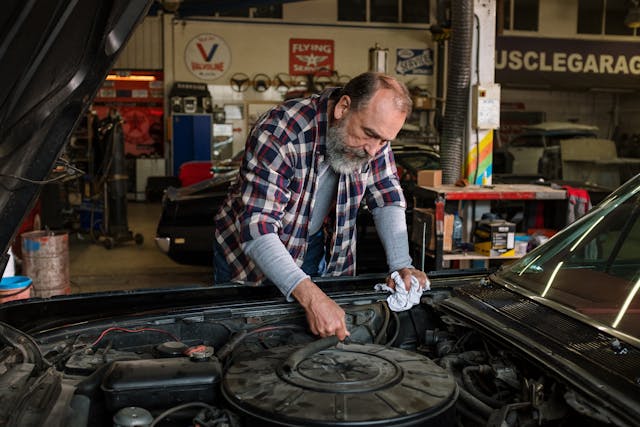Introduction:
Technological breakthroughs and innovation in the automobile sector have always been closely related. Using 3D printing technology into auto repairs is one of the most recent innovations changing the industry. Traditional replacement component procurement techniques are frequently expensive and require long wait times. But with the introduction of 3D printing and the production of components on demand, auto maintenance is going through a major change. This article examines how these technological advancements are transforming vehicle repairs and improving the accessibility and general effectiveness of auto maintenance.

The Use of 3D Printing in Auto Repairs is Growing:
Layering materials like plastic, metal, or composite materials to create three-dimensional items is known as additive manufacturing, or 3D printing. 3D printing was first mostly utilized for small-scale manufacturing and development, but technology has quickly found new uses in the automobile sector.
The capacity of 3D printing to create bespoke parts swiftly and affordably is one of the technology’s biggest benefits for auto maintenance. In contrast to conventional manufacturing processes that need costly tooling and extended lead times, 3D printing enables the on-demand creation of intricate components with little setup time. This feature is especially helpful for fixing rare or older cars, for whom finding original components might be difficult or impossible.
Additionally, 3D printing makes it possible for vehicle repair businesses and enthusiasts to create components right there, saving them money on storage and removing the need for large inventory. By streamlining the supply chain, improving inventory control, and reducing waste, this on-demand manufacturing strategy helps the automobile industry become more sustainable overall.
Improving Affordability and Accessibility:
For automobile owners, the use of 3D printing in auto maintenance also improves accessibility and cost. For older automobiles or vehicles with outdated components, 3D printing provides a more affordable option by offering an alternative to costly OEM (Original Equipment Manufacturer) parts.
Moreover, replacement components for automobiles that the manufacturer may no longer support may be made thanks to 3D printing. Because fans may now continue to maintain and repair vintage automobiles without encountering insurmountable challenges, this creates chances for prolonging the lifetime of older cars and conserving automotive history.
Boosting Customization and Innovation:

Beyond making repairs easier, 3D printing encourages creativity and personalization in the car sector. Professionals and hobbyists in the automotive industry may use 3D printing technology to design and create custom parts that improve performance or add aesthetic appeal.
When it comes to making distinctive body panels, interior trim pieces, or aftermarket extras, 3D printing customization lets people make their cars unique to their tastes and needs. This degree of adaptability fosters experimentation and creativity, which in turn propels an innovative culture within the automobile industry.
Obstacles and Prospects for the Future:
The extensive use of 3D printing in vehicle maintenance is not without difficulties, despite its many advantages. The dependability and safety of 3D-printed components in cars are contingent upon many major concerns, including quality control, material limits, and regulatory compliance.
Furthermore, even though 3D printing technology is developing quickly, further developments are required to improve speed, scalability, and material variety. To enhance the structural integrity of printed components, increase the variety of materials that may be printed, and optimize 3D printing procedures, research and development activities are still under progress.
The future seems bright for improving 3D printing operations, cutting manufacturing costs, and improving component performance with the integration of AI and machine learning algorithms. The potential for transforming vehicle repairs will only increase as these technologies develop and become more widely available, eventually helping customers, companies, and the automobile sector as a whole.
Problems and Solutions:
Quality Control: For the safety of automobiles, it is crucial to guarantee the dependability and quality of 3D-printed components. To address concerns about component durability and performance, strict quality control methods, such as standard testing procedures and material certifications, may be put in place.
Material Restrictions: Although 3D printing provides a broad range of material options, certain automotive-grade materials may still have restricted performance or availability. More investigation into cutting-edge materials including composites, metal alloys, and high-strength polymers may increase the potential uses of 3D-printed vehicle parts.
Regulatory Compliance: In order to guarantee adherence to industry rules and safety criteria, automobile components must meet regulatory standards and certification requirements. In order to enable the broad use of 3D-printed automobile components, manufacturers, technology suppliers, and regulatory bodies may work together to ease the establishment of rules for certifying these parts.
Scalability and Production Efficiency: One of the fundamental challenges in 3D printing is optimizing procedures for both scalability and production efficiency. Technological developments in additive manufacturing, such as increased print speeds, the ability to print multiple materials, and automated post-processing methods, may improve productivity and shorten lead times for creating large quantities of components.
Prospects for the Future and Possible Developments:

AI-Driven Design and Optimization: The design and optimization of 3D-printed automobile components may be completely transformed by combining artificial intelligence (AI) with machine learning methods. AI-driven generative design tools may produce ideal part shapes on their own, taking into account manufacturing limitations and performance standards. This results in components that are strong, light, and use little material.
Multi-Material Printing: With the development of multi-material 3D printing technology, intricate, multi-functional components with different material characteristics may be produced. This capacity creates opportunities for the development of hybrid components that blend several materials, including metals, polymers, and ceramics, to provide better functionality and performance.
In-Situ Repair and Maintenance: The development of transportable, on-location 3D printing technologies makes it possible to repair and maintain automobiles in-situ, cutting down on downtime and associated expenses. In order to improve serviceability and operational efficiency, automotive personnel may use portable 3D printers to produce replacement parts right at the point of need, whether in the field or at distant locations.
Bio-Inspired Materials and Structures: Researchers are investigating bio-inspired materials and structures for 3D printing car components, taking their cues from nature. Biomimetic design concepts may provide components with improved sustainability, durability, and impact resistance. Examples of these include lightweight composites, hierarchical architectures, and self-healing materials.
Digital Spare components Inventories: By using 3D printing technology to digitize spare part inventories, virtual warehouses are created where components are kept as digital files rather than actual stock. This digital inventory solution lowers storage costs and minimizes supply chain interruptions by enabling on-demand component manufacture and delivery.
In summary:
The use of 3D printing in car maintenance is a revolutionary development in the upkeep and servicing of automobiles. The automobile sector may reap the benefits of increased efficiency, sustainability, and innovation by embracing future technological advancements and production methods, while also addressing issues with quality control, material constraints, and regulatory compliance. The influence of 3D printing on vehicle repairs will only increase as technology develops and becomes more sophisticated, opening the door to a day when customized, on-demand manufacturing will be the standard and auto maintenance will be easier, more economical, and more effective than in the past.
Frequently Asked Questions (FAQ) Concerning 3D Printing and On-Demand Parts Revolutionizing Auto Repairs:
1. In the context of vehicle maintenance, what is 3D printing?
Using a digital model as a guide, 3D printing, sometimes referred to as additive manufacturing, is the process of building three-dimensional items by layering on material. 3D printing is utilized in auto repairs to create prototypes, customized car parts, and replacement parts.
2. Why is 3D printing advantageous for auto repairs?
For auto repairs, 3D printing has a number of advantages. These include:
replacement components produced on demand, cutting down on lead times and inventory expenses.
modification of parts to suit particular cars or satisfy personal tastes.
availability of components for vintage or uncommon cars that may not be produced or easily obtained.
3. What kinds of automotive components are amenable to 3D printing?
Car parts that may be 3D printed include brackets, structural elements, engine components, exterior and interior pieces, and engine components. 3D printing’s flexibility makes it possible to produce pieces that are both aesthetically pleasing and practical.
4. Do conventional components outlast 3D-printed ones in terms of durability?
The material choice, printing process, and component design are some of the variables that affect how long-lasting 3D-printed parts are. The durability and performance of 3D-printed items have grown due to developments in additive manufacturing techniques and materials, even if certain 3D-printed materials may not match the strength of conventional materials like metal.
5. How does the production of components for on-demand operate?
Producing components as required replaces keeping significant stockpiles of already-manufactured parts in on-demand parts manufacturing. By storing digital data of components, 3D printing makes it possible to avoid large warehouses and save storage costs by instantly producing needed parts using a 3D printer.
6. Can all kinds of car repairs be made using 3D printing technology?
Absolutely, repairs on a variety of vehicles, including automobiles, trucks, motorcycles, and even specialist vehicles like boats or airplanes, can be made using 3D printing. However, there are a number of variables that might affect the viability of employing 3D printing for repairs, including the accessibility of appropriate 3D printing equipment, supplies, and knowledge.
7. Are there any restrictions or difficulties while repairing cars using 3D printing?
Even though 3D printing has numerous benefits, there are also drawbacks to take into account, like:
Quality control to guarantee 3D-printed items’ dependability and security.
Material restrictions, as not all materials are appropriate for use in automobiles.
Adherence to regulations in order to fulfill certification criteria and industry standards.
8. How will 3D printing affect auto maintenance in the future?
With continuous improvements in materials and technology, the use of 3D printing in auto repairs seems to have a bright future. AI-driven design optimization, multi-material printing capabilities, in-situ repair solutions, and digital spare parts inventories are a few possible advancements. These developments might further simplify vehicle maintenance, expand personalization choices, and boost the automobile sector’s general productivity.